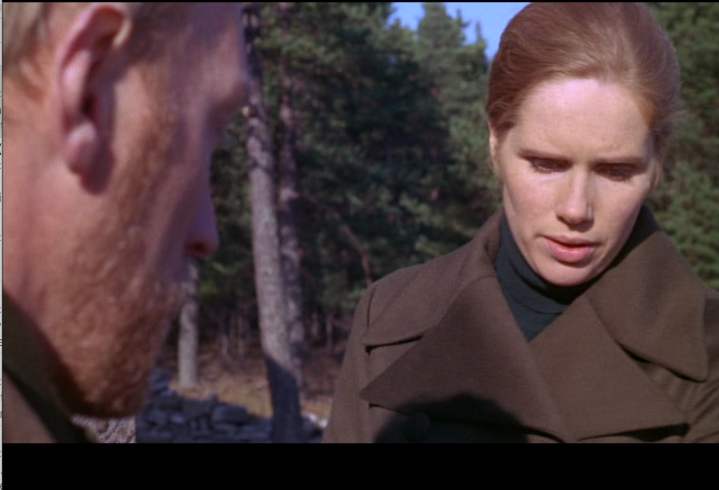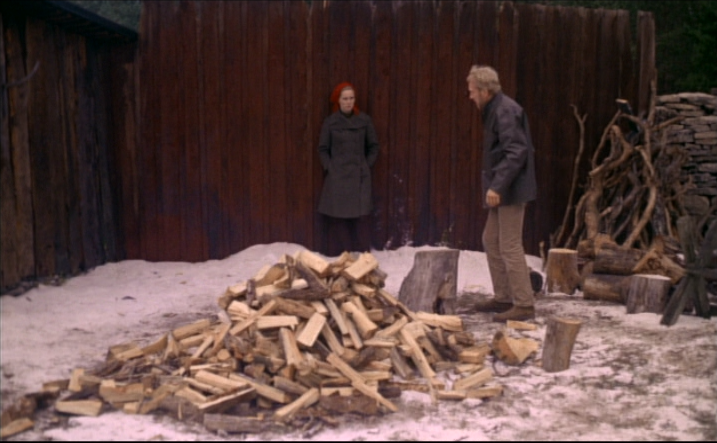

It is a powerful film and shows a break from accepted film practices.
Ingmar Bergman
Above all, I feel that the sounds of this world are so beautiful in themselves
that if only we could learn to listen to them properly, cinema would
have no need of music at all. Andrei Tarkovsky
The Passion of Anna was probably Bergman’s most experimental film. First of all he eliminated a music soundtrack (non-diegetic sound)—a radical decision as music was almost obligatory at that time for a feature film. Then he had the four main actors address the camera as themselves to discuss how they felt about their character they were playing. As well, he has these four actors improvise, most significantly in a prolonged dinner scene. Another innovation was showing a highly magnified excerpt of a letter that has a crucial impact on the storyline. And he used his own voice as an occasional commentator on the plot. Finally, he used sound effects in many creative ways to replace the absent music track.
Sound was very important to Bergman. He told Stig Bjorkman in 1970, just six months after making The Passion of Anna, “I’m so tired of poor sound in Swedish films.” (Bergman on Bergman, 258) And this film’s shows how seriously he took sound. Lenhart Engholm, who had worked on only two films with Bergman, was in charge of the sound. Ulf Nordholm, who was in charge of sound effects, was working with Bergman for the first time. It is interesting to note that credit for a sound-effects engineer was only given in Bergman films from 1960 (The Devil’s Eye) to Passion. This indicates that Bergman focused on sound effects more during the 1960s.
From 1944 Bergman almost always used a composer, especially Erik Nordgren, for his non-diegetic music soundtrack. As well, he would use recorded classical music, JS Bach being one of his favorites. For some of his most successful later films he used both specially composed music and recorded classical music: Wild Strawberries (1957); Through a Glass Darkly (1961); Persona (1966); and Hour of the Wolf (1967). For The Silence (1963) and Shame (1968) he used just classical music and for Winter Light (1963) only hymns.
Now, for Passion, he would eliminate all non-diegetic music. The only music in Passion is diegetic: two pieces of music played on record players by characters in the film: J.S. Bach’s Partita #3 and Allan Gray’s swing arrangement of “Always Romantic.” This music occupies only 6:27 of the film—6%. Bergman’s decision not to use a music track meant that there was a lot of space or silence for him to use sound effects. And in Passion he takes full advantage of this opportunity to augment the drama with sound effects.
Music
The small amount of music in Passion is all diegetic—heard by the characters. In his early films, Bergman used a non-diegetic soundtrack, employing mainly two Swedish composers, Erik Nordgren and Dag Wiren, to write music to support the action of his films. In the 1960s, starting with Winter Light he began to move away custom-written music and rely more on recorded classical music for his soundtracks. In Passion he used just two pieces of music diegetically. First is Bach’s Partita #3 on harpsichord. It is presumably played by Elis (one of the film’s four main characters) on his stereo. It runs while he first shows off his photographic collection and then photographs Andreas. Second is some swing music by Allan Gray (“Always Romantic”). It is played from a vinyl record chosen by Eva in Andreas’ home. It runs while Eva dances provocatively in front of him and then goes to sleep on a couch.
These two pieces of music run for a total of 6:27, just 6% of the length of the film. So there is a lot of “space” for sound (90%), and Bergman makes full use of the 94 minutes with a variety of sound effects. Most of these are diegetic (the roar of a bonfire, the sound of waves). They work of course to emphasize realism. But on another level Bergman uses them to enhance his film.
Ambient Sounds: Sea and Wind
The island setting requires ambient sounds of the ocean and of the wind for outdoor scenes. And the audience hears—and notices-- such ambient sounds because there is no musical soundtrack. Outdoors, the audience is constantly reminded of the marine location and Bergman uses this ambient sound consistently and effectively to enhance realism. But he also manipulates marine sounds to enforce emotions. A good example is the “ax” scene near the end of the film (89:00), where Andreas argues with Anna and loses self-control. This scene begins with a calm ambient sound but quickly escalates to a marine storm sound when the argument climaxes. Another example can be found at the start of the film when Andreas, working on his roof, sees three suns. Up to this point (3:10) the ambient marine sound is low and calm, but when the strange solar phenomenon registers with Andreas, the sound of wind rises to enhance the unease of Andreas. Another example of unnatural wind sound is in Anna’s dream (71:08).
Foghorn Sound
Bergman uses the sound of a foghorn from 27:48 to 33:25. During this sequence the horn sounds 28 times and not always consistently, suggesting that the foghorn is intended to be symbolic rather than realistic. The 5:37-long sequence focuses on Andreas dealing with disturbing information about Anna. He is considering an affair with her and is clearly stressed by the situation. He gets really drunk in his widow’s pottery studio, rides a bike across his yard, staggers into the forest, and slumps down in the snow against a small tree. All the time the foghorn is blaring. He clearly wants an answer to his dilemma and becomes angry that he can’t resolve it: “I hear not a sound. Not a damn thing.” But he does hear something—the foghorn, that is obviously warning him that danger is ahead. However, this doesn’t register in his drunk mind, and he goes on to get involved with Anna. The foghorn continues in his sequence when Andreas is rescued by Johan and taken safely to his home.
Clock Sound
Bergman regularly uses the sound of a ticking clock for indoor scenes, especially those in Andreas’ home. But he is not using this ticking primarily as an ambient sound. Not all the scenes in Andreas’ home have the ticking. Bergman also uses a ticking clock for the scene in Johan’s cabin when Andreas surveys Johan’s body. This ticking, which is often barely audible when characters are speaking, appears to serve as a way of heightening tension. It suggests a certain inevitability. A ticking time bomb.
Sometimes the volume of the ticking increases in order to enhance the drama (79:40). It is used to emphasize part of Anna’s letter that Andreas reads secretly. Bergman uses an unusual technique to do this—the camera follows a magnification of the typed letter along the text line by line (11:59-12:52, 21:51-22:10, 63:17-63:31). The first and longest excerpt begins with Andreas’ voice reading the text. Then after the words “psychological and physical violence,” his voice stops. The ticking, which had been low up to this point, now becomes louder. The excerpt ends with a visual repetition of “psychological and physical violence.” Two other excerpts with the typed text have no voice over and are accompanied the loud ticking. Both these two excerpts also end with “psychological and physical violence.” Thus the louder ticking in these three excerpts emphasize “psychological and physical violence,” an important theme in the film. And the relentless ticking heightens the drama.
Wrist-Watch Sound
This sound is heard the first time in Anna’s dream when she is running away at the end of the sequence. Suddenly there is no sound except a watch tick (73:57). Bergman also uses the sound of a ticking watch right at the end of the film when Andreas forces Anna to stop the car. When the final dialogue begins (99:42), the rapid watch tick is barely audible. Then as the tension rises, so does the ticking, though it’s never loud. The ticking stops (or becomes inaudible) as Anna delivers her final words and drives off. Then it starts again as Andreas begins pacing up and down the road. As the camera slowly closes in on him and loses focus, the ticking grows louder and continues to the sudden drumbeat that signals the end of the film.
Breathing and Coughing
Normal breathing is rarely hears in films, but because of the absence of a music score, Bergman is able to let the audience hear the breathing of the characters. This occurs right at the start of the film when Andreas is repairing his roof. Also we hear the broken breathing of Anna after she has phoned Stockholm.(8:20) Then when Johan has rescued Andreas and taken him home, breathing is heard again. Related to these breathing sound effects are Andreas sighing (87:38) and Johan’s coughing (30:15)
Chimes/Bells
The early part of the film has several ringing sound effects. Over the credits at the very start, Bergman uses high-pitched ringing sounds, probably coming from several different hand bells. Immediately after the credits end we hear a different kind of bell as sheep cross the landscape at twilight while Andreas works on the roof of his home (01:46). A sheep bell is heard again when Andreas disturbs a sheep (14:40). A clock chime (48:40) and then a church bell (48:47) are heard after Andreas and Eva have made love—a blatant religious comment.
Drum
Bergman uses the single beat of a bass drum three times. The first is heard at the end of Anna’s dream (74:06). Then, near the end of the film Bergman uses the beat of a bass drum to signal Anna’s sudden remembrance of her car crash (96:22, 97:26). Finally, right at the end of the film a strong bass drum abruptly announces its conclusion.

Emphasized Sounds
As with the volume of clock sounds that Bergman sometimes increased, there are other sounds that he amplified to make a statement. For example, at the last breakfast when the relationship between Anna and Andreas finally breaks down, the sound of Anna’s crunching he toast is amplified unnaturally (89:02). This sound begins quietly but gradually and unrealistically gets noisier, becoming a breaking point for Andreas who abruptly leaves the table and goes outdoors to chop firewood manically. The sound of fires (34:20, 94:03) is also amplified to underline one of the films main themes. Other examples includes, a falling cement bucket (03:45), Anna dropping the bowl of milk (84:17), the fire engine sirens (43:40), and Anna’s typing during Andreas’s sexual fantasy (81:40).
Leave a Comment